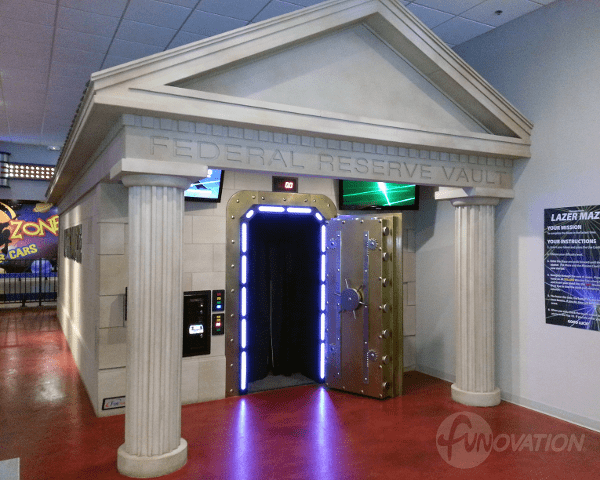The right small attraction strategy can make a big difference in your guest experience – and your bottom line.
Maximizing profitability in your family or location-based entertainment center means operating efficiently in all areas, and one of those areas is in utilizing your space in a smart manner. Small-footprint attractions can be a terrific way to boost revenue and give you an opportunity to engage more with your guests. But like everything else in your facility, success won’t happen by chance.
We sat down recently with Ryan Borton, CEO of Funovation, the manufacturer and distributor of some of the most popular small-footprint attractions available, including Laser Maze Challenge®. We asked Ryan to share his best advice about adding a small footprint attraction to your mix. Read on for his top things to consider before you add a small-footprint attraction.
No. 1: Determine if you have the time to add a new attraction.
Ryan: The very first thing you need to consider is whether you really have time – not just money – to invest in a new attraction. Just like when opening your business, installing an anchor attraction, or launching a new menu, you need to market it so that people know it’s there and you build buzz around it. You’re going to get out of it what you put in so make sure you think about marketing it, packaging it with other attractions, and how you’re going to integrate it into your overall marketing strategy.
No. 2: Consider appealing to a broad demographic.
Ryan: For some facilities, your anchor attractions are geared towards a specific demographic, and that often makes a lot of sense. But let’s say you have a trampoline or an adventure park. A grandmother brings her grandchildren and watches them play, but she might not feel comfortable participating in the anchor attractions.
That said, the right small-footprint attraction could be something that allows them to play together, making memories and enjoying your facility even more. It’s a good idea to think about how any new attractions might complement your existing mix to make your offering even larger.
No 3: Consider the right product placement.
Ryan: Don’t put Baby in the corner. You want your new attraction to shine and to do that, people need to see it in your facility. We’ve seen facilities triple their small footprint attraction revenue just by moving it in the facility.
You’ll definitely want to strategize the best place to install it and how you will highlight it within your facility. Is it naturally going to be visible? What can you do with lighting, signage, floor markers, or even TVs to promote your new attraction? And actually, this isn’t just an issue with small attractions. We see this in facilities with multiple large attractions all the time. What good is a state-of-the-art anchor attraction like laser tag if nobody knows it’s there?
No. 4: Get a firm handle on throughput.
Ryan: In order to decide if an attraction is right for you, you need to understand what it’s capable of producing for you. How many players per hour will you be able to accommodate? Does the attraction drive repeat plays or will someone only try it once? Think about whether there is any type of competition or excitement factor that will encourage guests to want to play over and over again.
Make sure that you’re asking for usage data from a supplier when you’re evaluating an attraction. You should be able to get specific data about how many guests are playing an attraction multiple times if it’s an established product. See if you can get card swipe data from low, medium, and high-producing locations to get a feel for the attraction’s potential.
No. 5: Don’t think of it as just another game.
Ryan: These attractions are typically under 500 square feet, so you don’t need a big area. You might think it would be better to use the space to add another couple of games. Adding more games isn’t a bad strategy, but you need to weigh that against whether adding a new attraction would offer a more compelling experience that could be leveraged to drive more traffic overall.
You can often charge more for an attraction, plus you have the ability to bundle it to create bigger ticket packages or to add value to memberships, etc.
No. 6: Remember the overall goals.
Ryan: One of the main goals of a small-footprint attraction is to keep people in the building. No one wants to come to your facility, do your anchor attraction, then turn around and have nothing else to do. Consider whether your new attraction is going to encourage them to stay – and better yet, give them a reason to return, with more opportunities to eat, drink, and play at your facility. That’s what it’s all about, right?
We can’t thank Funovation’s Ryan Borton enough for sharing these extremely valuable insights to help you maximize potential in small-footprint attractions. Have questions for Ryan or want to learn about the attractions available from Funovation, reach out to him at ryan.borton@funovation.com.
Search Resources
Subscribe to Email Updates
Featured Resources
News //
CenterEdge Chosen as Exclusive Software Partner for Launch Entertainment Growth Plan

Blogs //
How to Build Better Relationships With Your Guests

Blogs //
7 Steps to an Improved Guest Experience

Blogs //
5 Features of CenterEdge’s New Integration with Semnox

Posts by Topic
- Advantage Payments (7)
- Brand Management (19)
- Business Growth (81)
- Capacity Management (2)
- CenterEdge News (30)
- Client Interviews (9)
- Credit Card Processing (3)
- Data & Reporting (12)
- Digital Signage (1)
- Event Management (20)
- Facility Management (10)
- Food & Beverage (8)
- Guest Experience (34)
- Guest Management (20)
- Holiday Season & Promotions (5)
- Industry Events (12)
- Inventory Management (1)
- Loyalty Programs (8)
- Marketing Tips (24)
- Operations (1)
- Point of Sale (10)
- Product Launch (11)
- Productivity (5)
- Profitability (35)
- Redemption Management (1)
- Sales (35)
- Season Passes (1)
- Team Training (60)
- Waivers (2)

Leave a Comment